Sapporo Soup Curry is a colorful dish of fall-off-the-bone chicken and crispy flash-fried vegetables in a light broth with curry powder and garam masala. Originating in Hokkaido, this comforting soup is a relatively new addition to the Japanese curry scene.
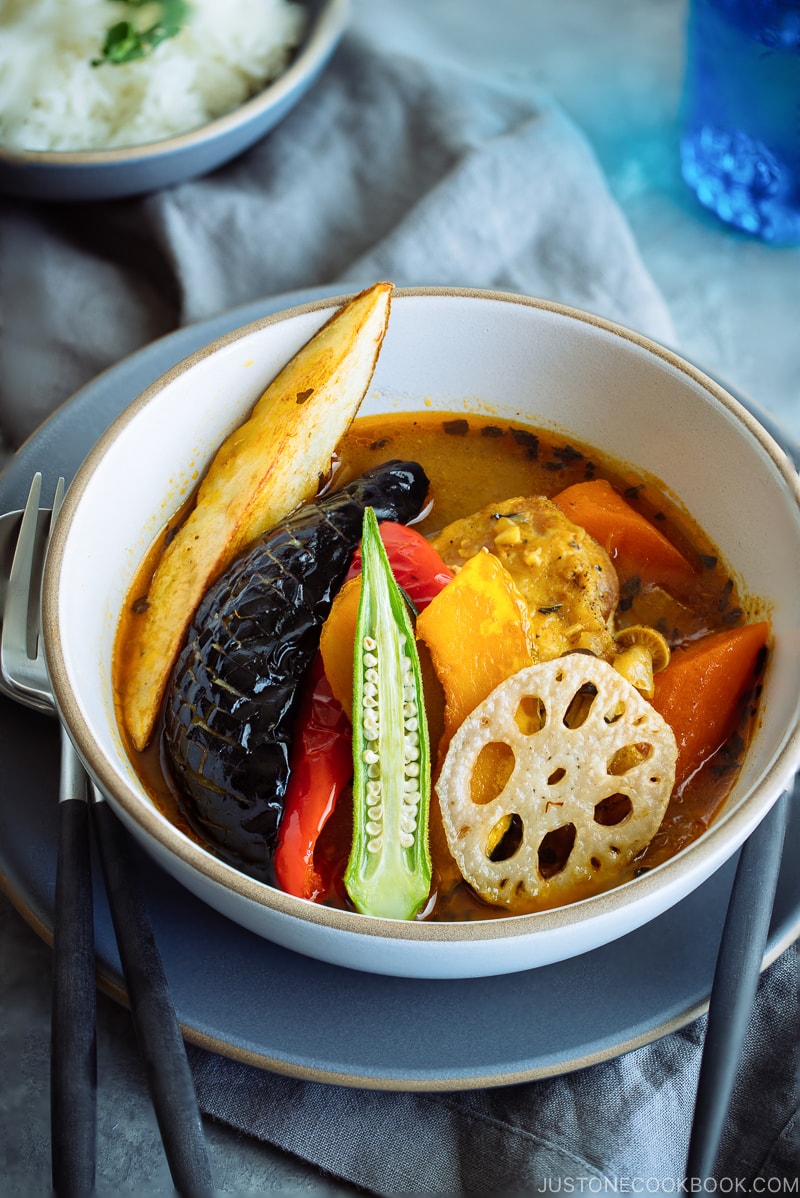
Most notably known as the birthplace of the oldest beer in Japan, Sapporo, the capital of Hokkaido, is also a food lover’s paradise. You can find incredibly fresh seafood, seasonal vegetables from local farms, and high-quality dairy products, all of which contribute to its thriving food scene.
Aside from the famous soft-serve ice cream, snow crab, and jingisu kan (barbecue-style mutton dish), another local specialty that any visitors to the snowy city must-try is Soup Curry (スープカレー). Served piping hot and filled with nutritious ingredients and flavorful spices, this amazing curry dish is one of the best cure-alls on a cold, snowy day, or any day when your curry craving hits.
Table of Contents
What is Soup Curry?
The original soup curry was firstly created by a cafe in Sapporo in the early 70’s. Inspired by a Chinese/Korean medicinal soup and curry from Indonesia, Thailand, Sri Lanka, and India, it was a clever adaptation of all these different influences with local elements in mind. By the 2000’s, more specialty shops started popping up everywhere in Sapporo and soup curry became Sapporo’s new signature dish.
The typical Sapporo soup curry consists of the following: a light curry flavored soup, chicken leg, and non-battered deep-fried vegetables (su-age style, 素揚げ) such as eggplants, potatoes, carrots, bell peppers, okra, and kabocha squash. Unlike the typical Japanese curry, steamed rice is always served separately. You scoop up the rice and then dip into the soup curry to enjoy together. When you’re almost done with the rice, you transfer the remaining rice into the soup curry and enjoy the last bits together.
With so much vibrancy and comfort that comes with the curry, it is no wonder the locals go wild about it. There’s no better way to keep you through the long winter nights with this restorative dish.
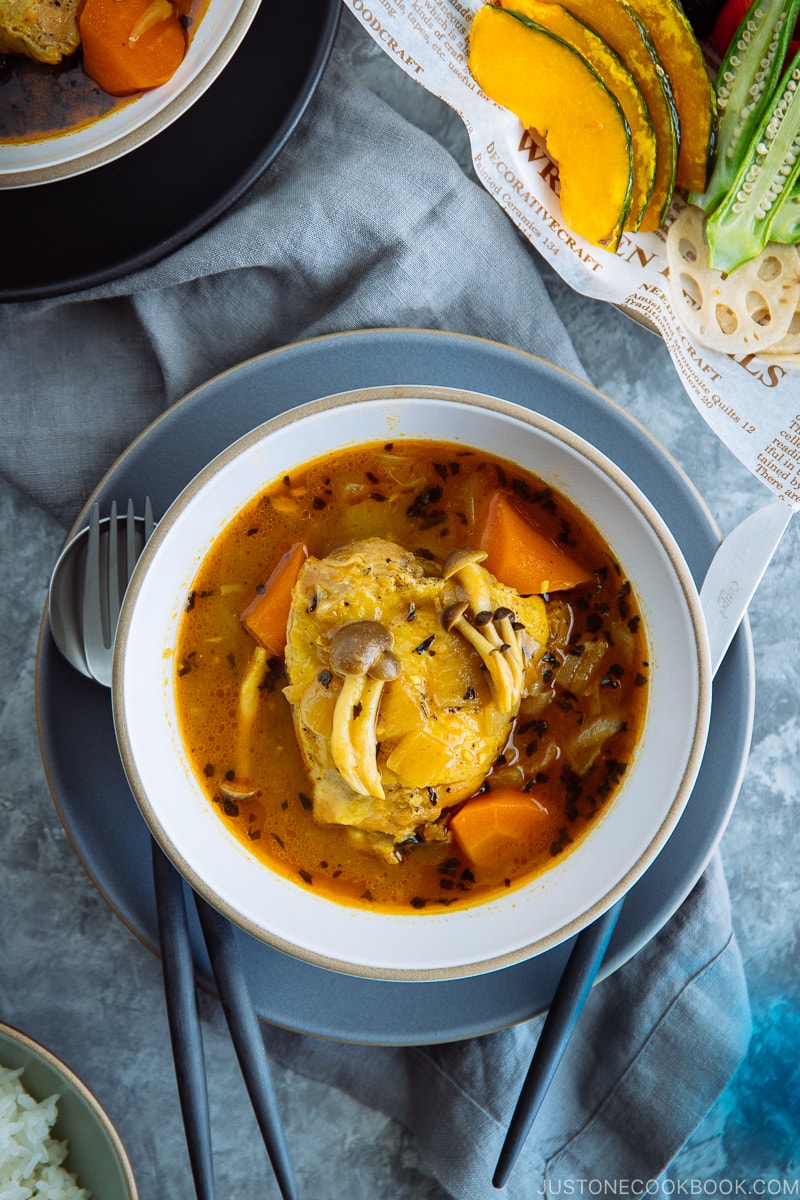
5 Key Points for Soup Curry
1. Soupy
As the name suggests, Sapporo soup curry is soupy—it’s thin and watery, not thick like regular Japanese curry rice.
2. Layers of spices
When Japanese make curry, we rely on the store-bought curry roux like this. However, for soup curry, you add more spices like curry powder, garam masala, basil, etc. The fun part of this recipe is you can create your own spice blend for the soup curry and easily adjust to your own likings. My friend who helped me create this recipe uses honey and mango chutney. My kids and I love these additions in our soup curry as well.
3. Colorful and Chunky Ingredients
Soup curry has very colorful and chunkier vegetables as you don’t cook them in the curry with meat and stock. Instead, vegetables are deep fried without batter (Japanese su-age technique) and served on top of the curry at the end. More about the su-age technique later.
4. Varying Textures
You get to enjoy fall-off-the-bone chicken, tender carrots, and crisp deep-fried vegetables all in one bowl. The varying textures add a distinctive presentation and enjoyment to the curry dish.
5. Rice is Served Separately
Unlike a typical Japanese curry rice, Sapporo soup curry is served with steamed rice in a separate bowl or a plate.

What is Su-age (素揚げ)?
Su-age is basically flash-fried without coating any flour or batter. Su means natural or uncoated in this case and age (pronounce a-geh) means deep-frying. Cooking time varies from 30 seconds (bell peppers) to 3 minutes (potatoes).
This traditional Japanese cooking technique is used to preserve or intensify ingredients’ original flavors, vibrant colors, and shapes. I have used this technique in recipes like Eggplant Agebitashi and Sweet and Sour Chicken.

If you’re using a pressure cooker, making the soup curry itself is a doable task. The flash-frying is where it takes a little longer time. You can choose to skip the deep-fried vegetables, but then again, who wants to miss out the best part of this delicious dish. So, if you’re going to make this Sapporo-signature soup curry, go ahead and indulge yourself. It’s totally worth the effort!
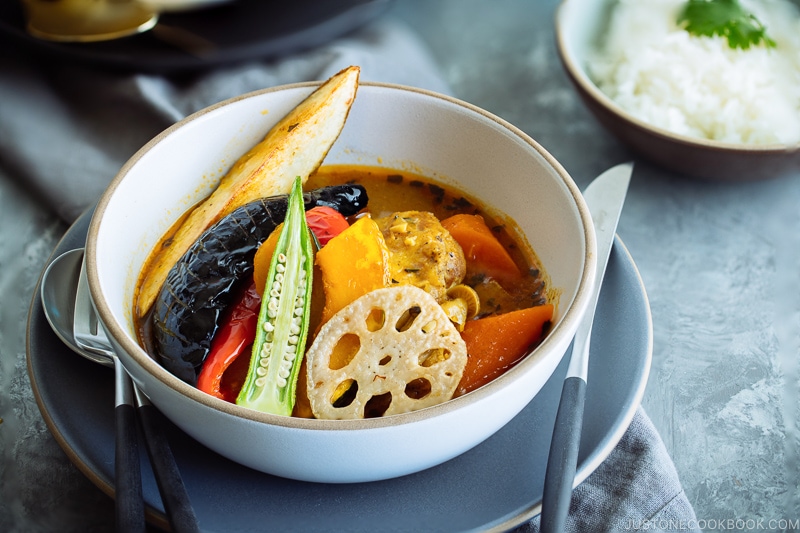
Wish to learn more about Japanese cooking? Sign up for our free newsletter to receive cooking tips & recipe updates! And stay in touch with me on Facebook, Pinterest, YouTube, and Instagram.
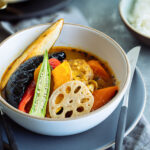
Sapporo Soup Curry
Video
Ingredients
For the Steamed Rice
- 1½ cups uncooked Japanese short-grain white rice (2 rice cooker cups, 360 ml; yields 4⅓ cups, 660 g of cooked rice)
- water (fill to the 2-cup water line on a multi-cooker‘s inner pot; or cook the rice in a rice cooker, pot on the stove, donabe, or Instant Pot)
For the Soup Curry
- 1 onion
- 1 carrot
- 1 package shimeji mushrooms
- 3 cloves garlic
- 1 knob ginger (1-inch, 2.5 cm per knob; peeled)
- 2.5 lb bone-in skin-on chicken thighs (about 6 pieces)
- 1 tsp Diamond Crystal kosher salt (for the chicken)
- freshly ground black pepper
- ½ Tbsp extra virgin olive oil
- 1 Tbsp unsalted butter
- ¼ tsp Diamond Crystal kosher salt (for the onion)
- 3 cups chicken stock/broth
- 1 Tbsp dry basil
- 1 bay leaf
- 1 tsp Diamond Crystal kosher salt (to taste)
- 1 tsp soy sauce
For the Seasonings
- 1 cube Japanese curry roux (1 small square block)
- 1 Tbsp Japanese curry powder
- 1 tsp garam masala
- 1 Tbsp tomato paste
- 1 Tbsp honey
- 1½ Tbsp mango chutney
For the Flash-Fried Vegetables
- 1 russet potato
- ½ red bell pepper
- 2 okra
- 2 Japanese or Chinese eggplants
- 2 inches lotus root (renkon)
- 2 oz kabocha squash
- 1 cup neutral oil (for frying)
Instructions
- Before You Start: For this recipe, I use a multi-cooker to steam the rice, stir-fry the ingredients, and pressure cook the soup curry. For Instant Pot instructions, see the end Notes. Alternatively, you can use a pot on the stove to sauté and cook the soup curry. For the steamed rice, you could also cook it in a rice cooker, pot on the stove, donabe, and Instant Pot; please see those recipes for how much water to use. Note that the rice-to-water ratio is 1 to 1.1 (or 1.2) for short-grain white rice.
To Make the Steamed Rice
- Rinse and wash 1½ cups uncooked Japanese short-grain white rice 3 times and drain well. For step-by-step instructions of how to measure and rinse, see my post on how to make rice. Place the rice in the inner pot of the cooker, then add water up to the 2-cup water line. Close the lid.
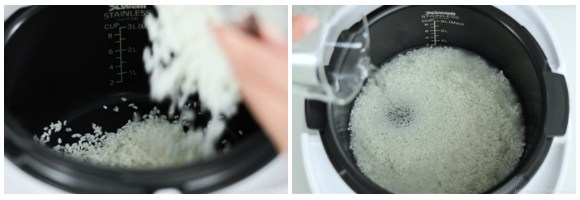
- Select the Rice menu on the multi-cooker, then set the steam time to 8 minutes. Press the Cook button. When cooking is completed, warming will start. Fluff up the rice with a rice scooper. Tip: Adjust the cooking time and water according to your personal taste.
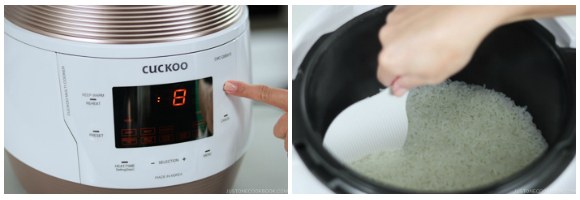
To Prepare the Ingredients
- Gather all the ingredients. Measure the seasonings ahead of time: 1 cube Japanese curry roux, 1 Tbsp Japanese curry powder, 1 tsp garam masala, 1 Tbsp tomato paste, 1½ Tbsp mango chutney, and 1 Tbsp honey.
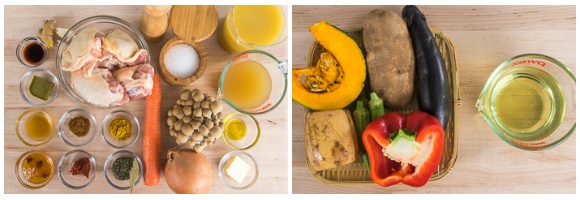
- Dice 1 onion.
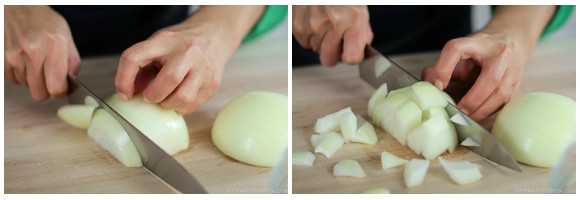
- Peel and cut 1 carrot into small pieces. I use the rangiri Japanese cutting method to increase the surface area so the carrot cooks evenly and faster and absorbs more flavor.
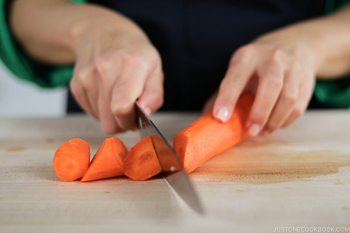
- Mince 3 cloves garlic and grate 1 knob ginger.
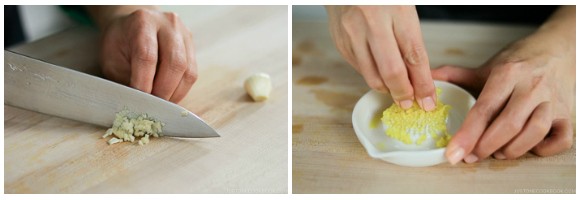
- Open 1 package shimeji mushrooms and cut off the bottom root end. Separate the mushrooms into small clusters.
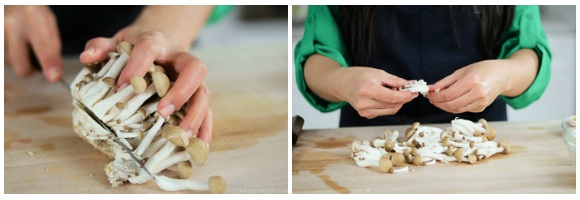
- Pat dry 2.5 lb bone-in skin-on chicken thighs with paper towels to remove any moisture. Season the chicken with 1 tsp Diamond Crystal kosher salt and freshly ground black pepper.

To Stir-Fry
- Set the cooker to Browning Fry, level 6 for 30 minutes. You can add more minutes later if you need extra time.
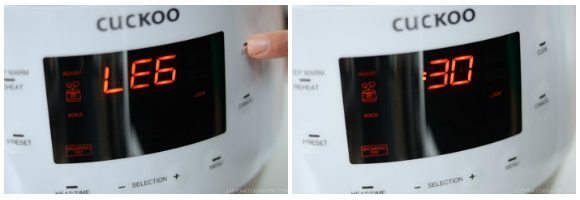
- Heat ½ Tbsp extra virgin olive oil and brown the chicken, skin side down, for 5 minutes each side, or until golden brown. Don’t crowd the pot, and brown the chicken in batches, if necessary.
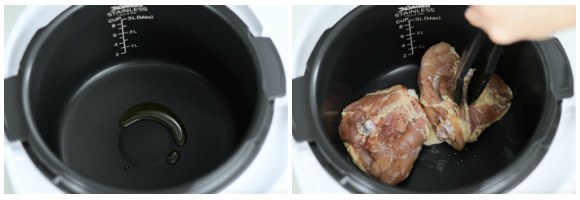
- After the bottom side is nicely browned, flip to cook the other side. Then, transfer the chicken to a plate and continue with the next batch. Set aside.
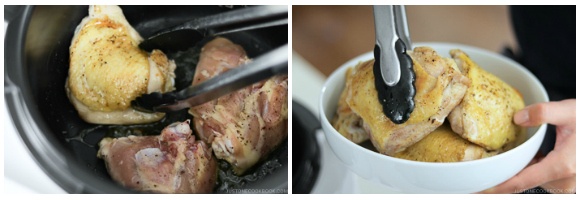
- Add the diced onion and 1 Tbsp unsalted butter. Add ¼ tsp Diamond Crystal kosher salt. Sauté until translucent, about 7–8 minutes.
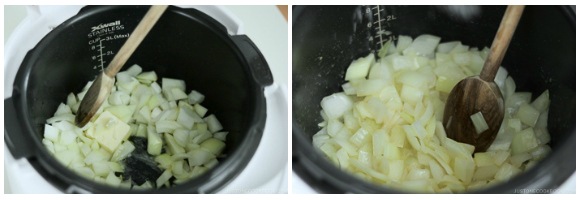
- Add the garlic and ginger and mix all together.
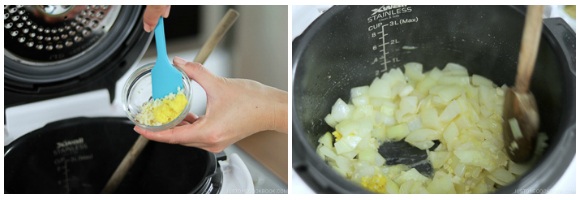
- Add the curry roux, curry powder, and garam masala. Give it a quick stir.

- Add the tomato paste and sauté until fragrant.
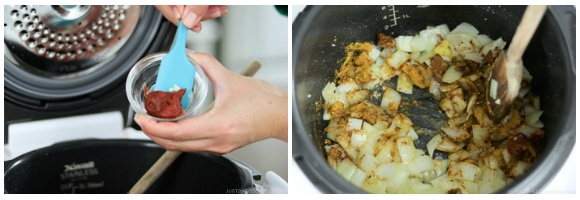
- Add the honey and mango chutney and mix all together.
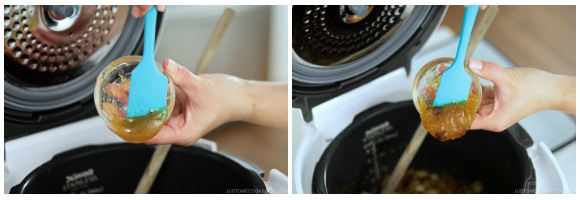
- Gradually add half of the 3 cups chicken stock/broth, scraping the brown bits on the bottom of the pot. Transfer the chicken back to the pot.
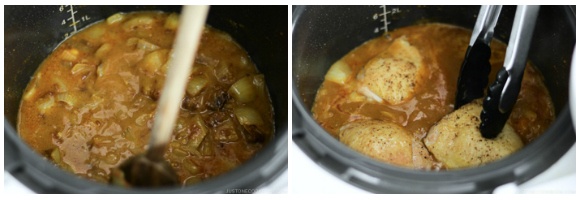
- Add the carrots, shimeji mushrooms, and rest of the chicken stock.

- Add 1 Tbsp dry basil and 1 bay leaf. Gently mix all together.
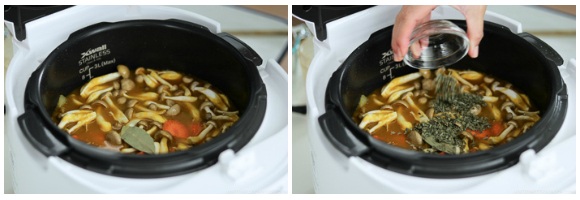
To Pressure Cook
- Close the lid and set cooker to Multi Cook, level 9 for 35 minutes. For Instant Pot directions, see the end Notes below.
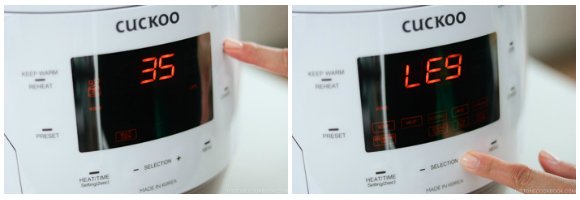
- Once pressure cooking is done, open the lid and stir. Add 1 tsp Diamond Crystal kosher salt and 1 tsp soy sauce.
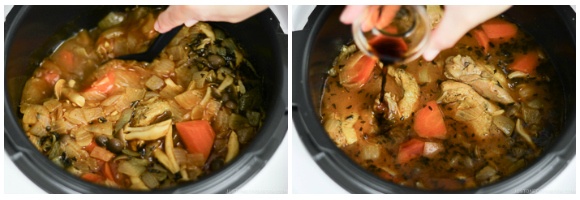
- Taste and adjust the flavor.
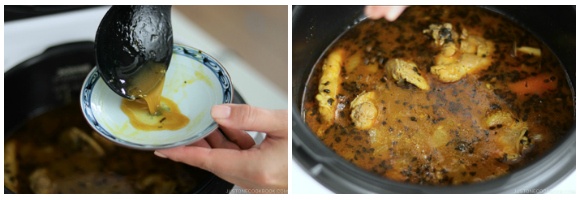
To Deep-Fry the Vegetables (optional)
- Lotus root: Thinly slice 2 inches lotus root (renkon) and soak in water (or ideally in 2 cups water + 1 tsp of rice vinegar) for 10 minutes.

- Bell pepper: Remove the seeds from ½ red bell pepper and cut into 4 wedges.

- Okra: Remove the hard top edges from 2 okra and cut in half lengthwise.
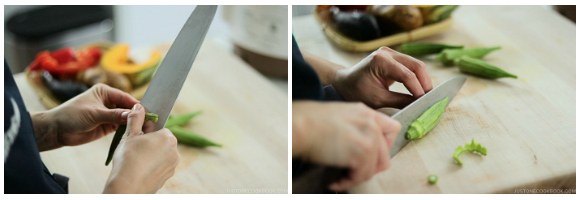
- Kabocha: Thinly slice 2 oz kabocha squash (cut in half if it’s too big). If the kabocha is too hard to cut, microwave first for 30 seconds or more.
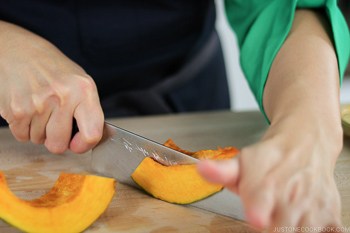
- Potato: Cut 1 russet potato into 6–8 wedges and soak in water for 10 minutes to remove the starch.
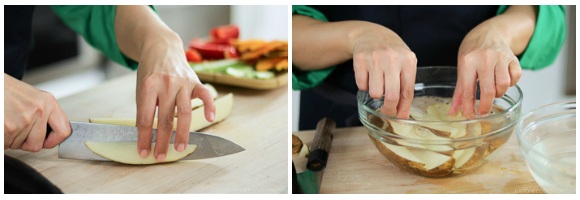
- Eggplant: Right before deep-frying (otherwise it’ll change color), cut 2 Japanese or Chinese eggplants in half lengthwise and score the skin side in a crisscross pattern. This creates a nice design and helps to absorb more flavors.
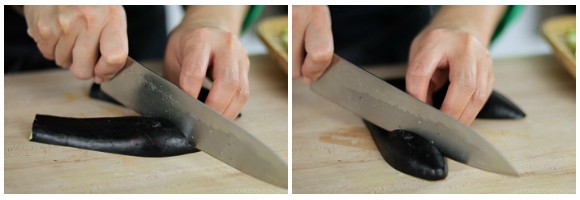
- Make sure to remove moisture from all the vegetables with a paper towel or kitchen towel before frying.
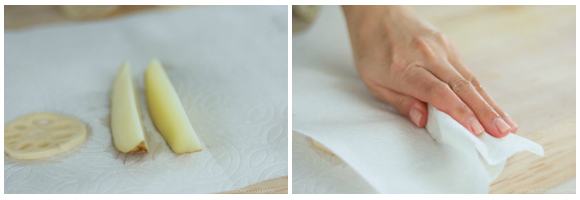
- Add 1 cup neutral oil to a frying pan (I use a cast iron pan) or deep, heavy-bottomed pot. Deep- or shallow-fry the vegetables at 350ºF (175ºC) and drain the excess oil on a paper towel or a wire rack.
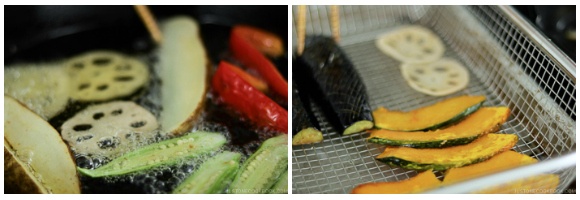
To Serve
- Serve the steamed rice in a small bowl or plate. Serve the soup curry separately in an individual soup bowl. Top the soup with the deep-fried vegetables. To eat, pick up some rice with a spoon, scoop some soup curry, and enjoy!
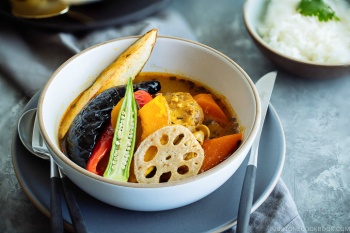
To Store
- You can keep the leftovers in an airtight container and store in the refrigerator for up to 3 days and in the freezer for a month.
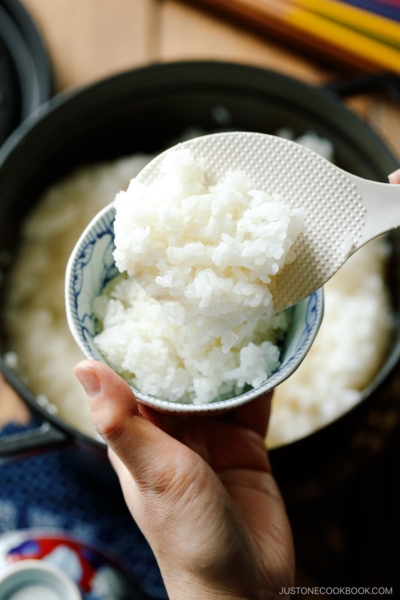
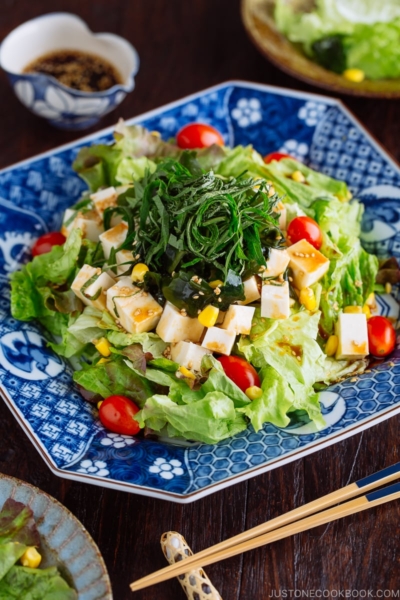
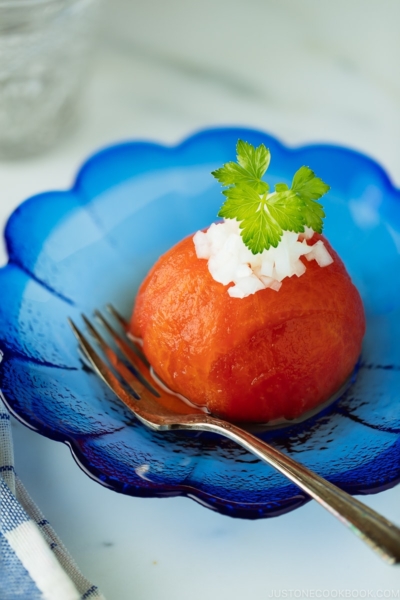
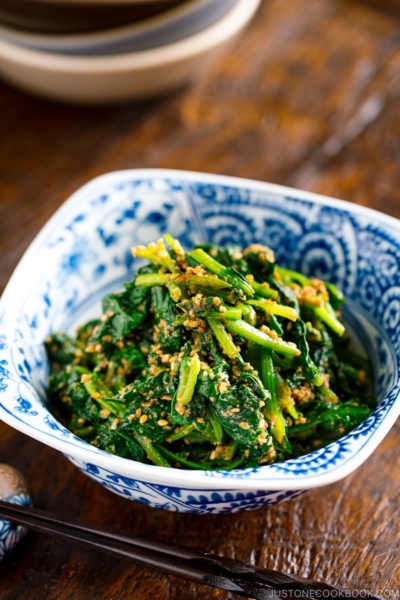




Hey! Are the nutritional values per serving or per batch? I used the ingredient amounts using “1x”. Which should be four servings!
Thank you!
Hello John! Thank you for trying Nami’s recipe!
The nutritional values are for approximately one serving, which includes rice. Please keep in mind that this is an estimate and should be used as a guideline. Hopefully, this helps!
Hello! This recipe looks delicous. I do not have a pressure cooker. How long should I cook the soup on a stove top or in a slow cooker.
Hello, Jake! Thank you for reading Nami’s post and trying her recipe.
In a slow cooker, simmer on LOW for 6-8 hours or HIGH for 3-4 hours.
It will take around 1 to 1.5 hours on the stovetop for the bone-in chicken to become soft and fall off the bone. Hopefully, this helps!
Is there really 60g fat per serve? 😱 Love this dish but didn’t realise how fatty it is haha.
Hi Jo, Thank you for reading Nami’s post!
This recipe contains a high-fat content due to the type of meat used. You can use skinless chicken if you prefer. Hopefully, this works for you.
Hi Namiko,
1/ i won’t be able to find mango chutney, what’s the substitute or can it be omitted?
2/ Also, my kitchen is tiny so difficult to Shu-age the vegetables- would it be alright to throw them into the soup with harder to cook first ? Will taste of curry soup be different?
3/ Japanese curry powder – is it alright to use normal Indian chicken curry powder?
Thanks so much and I’m from Singapore.
Hello Susan, thank you for reading Nami’s post. The mango chutney used in the soup curry is made with mango and aromatic spices like cardamom, cinnamon, and coriander. Skipping it may result in a bland taste. If you can’t find mango chutney, you can try using another fruit chutney like apricot or peach.
Su-age is optional, but if you add vegetables to the soup, it will become thicker and more like a traditional Japanese curry.
Japanese curry powder has a slightly different taste than Indian chicken curry powder, and it’s less hot. If you would like to learn more about Japanese curry and how to make it, you can check out this link: https://www.justonecookbook.com/japanese-curry-powder/
Remember that if you use a different seasoning, it will not have the same taste and flavor, but it is still worth trying using a similar kind.😉 Hope this helps!
Hello Nami,
I managed to get the mango chutney when I was on holiday in Austria. So cooked this last weekend and followed yr recipe closely. It was very good! Almost as good as the ones we ate in Sapporo in March 😋
I shall try to airfry or oven bake the veg next time.
Thanks heaps!
Hi, Susan! Thank you for the update! We’re so glad you enjoyed the soup!
Airfry sounds like a wonderful idea, too! 🤗
Can I air fry instead of deep fry the vegetables?
Hello, xtine. Thank you for trying Nami’s recipe.
Sure. It should work well. We hope you enjoy this dish.
Happy cooking!😊
Hi Nami. Is this soup easily adaptable for a vegetarian diet without sacrificing flavour that the chicken would bring to the soup? My partner and I really enjoy tofu. Do you have any recommendations on how to substitute tofu (or other protein alternatives) into the soup? I am really looking forward to trying this soup once I find Japanese curry powder! I love your recipes.
Hello Aly! Thank you for taking the time to read Nami’s post and trying out her recipe.
If you prefer a vegetarian option, you can use vegetable stock or broth instead of chicken. However, please note that you may need to adjust the flavor and cooking time accordingly. Another suggestion to enhance the flavor is to add more mushrooms.
If you would like to include tofu in the dish, you can add it at the start of the pressure cooker and cook it for around 10 minutes.
We hope these tips are helpful for you!
This is such an amazing soup!! We absolutely love it and look forward to making it all the time. So comforting, satisfying, flavorful, and exciting. We love a lot of your other recipes as well. Thank you!
Hi S C, Thank you so much for trying Nami’s recipes and leaving such a lovely comment.
Nami and all of us at JOC are so happy to hear you have been enjoying recipes from our site. Happy Cooking!